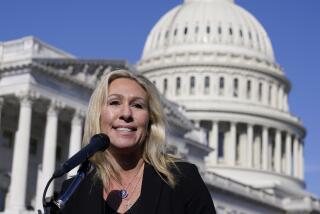Republicans applying ‘supply side’ theory to benefits
- Share via
The phrase “supply side” usually calls up visions of Ronald Reagan and the Laffer curve. That’s because it typically refers to supply-side economic theory, which argues that the way to promote production and economic growth is to cut marginal tax rates, especially the higher ones on upper incomes.
I’m not an economist, but I’d argue that there’s a second version of supply-side thinking at work in Washington these days. On a number of social programs, Republicans are trying to reduce the supply of federal dollars on the theory that the aid has driven up prices far faster than ordinary inflation.
The latest example is student financial aid. Democrats and Republicans have been tussling over a temporary extension of a 2007 law that cut the interest rate on subsidized Stafford loans. Both sides agree that the current rate -- 3.4% -- should be maintained for another year instead of letting it rise back to 6.8%. The battle is over how to offset the $6-billion cost.
The backdrop to this debate, however, is the House Republican budget proposal for the coming fiscal year. There, Budget Committee Chairman Paul D. Ryan (R-Wis.) argued that federal subsidies for education weren’t making college more affordable -- they were driving up its cost.
Here’s an excerpt from Ryan’s “The Path to Prosperity,” which explains the reasoning behind the budget proposal:
While financial aid is intended to make college more affordable, there is growing evidence that it has had the opposite effect. Economists such as Richard Vedder point out that the decisions of colleges and universities to raise their prices would have been constrained if the federal government had not stepped in so often to subsidize rising tuitions.
This line of thinking is actually known as “Bennett’s hypothesis,” a reference to former Education Secretary William Bennett, who complained in 1977 that federal aid enabled universities “blithely to raise their tuitions.” It’s disputed, but there is some evidence to support it. For example, a study this year by Stephanie Riegg Cellini and Claudia Goldin found strong evidence that federal aid led to higher tuition at for-profit colleges. And Andrew Gillen, research director at the Center for College Affordability and Productivity, released a report in February arguing that there is a link between tuition increases and education subsidies for middle-class and wealthy families (e.g., tuition tax credits).
I’m not going to take sides in that debate. I would note, however, that Gillen’s report contends that there is no connection between Pell grants (which go to lower-income students) and higher tuition. And the House budget proposal would roll back Pell grants rather than tuition tax credits.
A second illlustration of the new type of supply-side thinking is in Medicare. Starting with Ryan’s budget proposal last year and continuing this year, Republicans have been trying to make the case that healthcare costs are rising in part because of the open-ended supply of federal dollars. By switching to a “premium support” system that provides a limited subsidy for health coverage, proponents argue, seniors will be more sensitive to the cost of insurance and the underlying cost of care.
Again, from this year’s “The Path to Prosperity”:
Medicare subsidizes coverage for seniors to ensure that coverage is affordable. Affordability is a critical goal, but the subsidy structure of Medicare is fundamentally broken and drives costs in the wrong direction. The open-ended, blank-check nature of the Medicare subsidy drives health care inflation at an astonishing pace, threatens the solvency of this critical program, and creates inexcusable levels of waste in the system.
I won’t get into the pros and cons of premium support either, other than to note that The Times’ editorial board has praised the version proposed by Ryan with Sen. Ron Wyden (D-Ore.) The version in the House budget plan differs from the Wyden-Ryan proposal in a couple of notable ways, including setting a lower cap on the rate of growth in Medicare spending.
This alternate supply-side focus doesn’t come at the expense of the more traditional iteration, which many, if not most, Republicans on Capitol Hill adhere to. It’s not hard to find a Republican member of Congress who’ll argue that tax cuts would increase federal revenues by spurring economic growth. My point here is just that a pattern is emerging in how some influential Republicans look at benefit programs, and it focuses on the allegedly deleterious effects of supplying more federal dollars.
ALSO:
Medicare reform: This could work
Playing politics with student loan interest rates
Student cheats, gets caught, father sues -- what gives?
More to Read
A cure for the common opinion
Get thought-provoking perspectives with our weekly newsletter.
You may occasionally receive promotional content from the Los Angeles Times.











